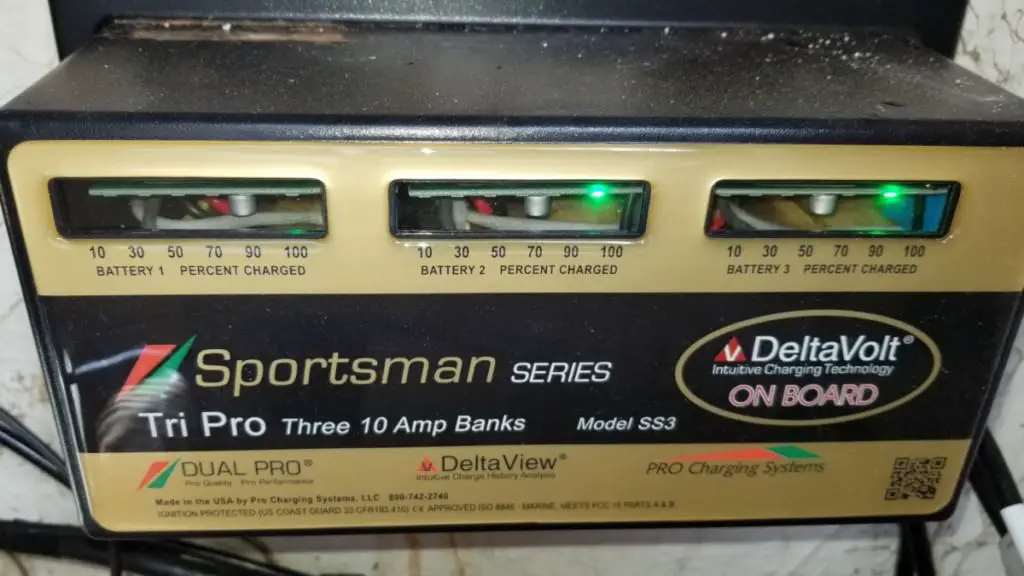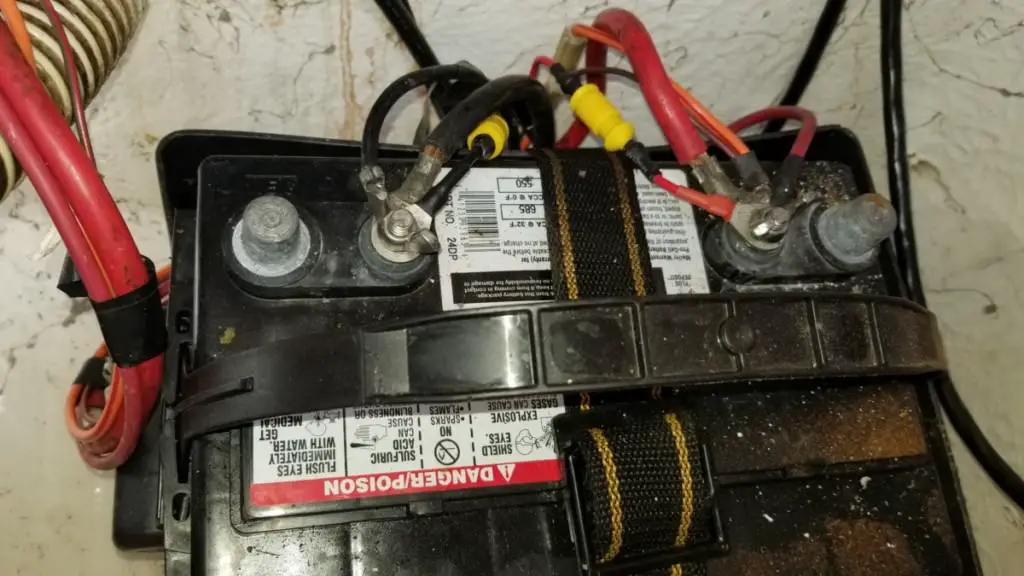When you’re hooked up to shore power and charging up your batteries, it can be quite unsettling to hear your marine batteries bubbling or even hissing over the quite evening while you’re enjoying a drink.
Is this normal for a marine battery to do this? Are you or your battery in any real danger?
A boat or marine battery will bubble or hiss due to overcharging. There are acceptable charging ranges that should not be exceeded for flooded, gel, and AGM batteries. Exceeding this range will lead to hissing and acid will leak to relieve pressure.
That’s the short answer, but there’s definitely more to cover to make sure you don’t damage your boat, ruin your batteries prematurely, or even hurt yourself or your family.
Let’s pull up anchor and cruise into this topic!
Why a Boat Battery Bubbles/Hisses
Your boat’s battery will bubble or hiss when the voltage is too high during the charging process, or if the amperage (current) is too high for the battery(ies) relative to their total ampere hours (AH).
For instance, a charge above 14.1 at room temperature will lead to a state of overcharging and bubbling/hissing for a sealed gel battery regardless of the total ampere-hours.
On the same note, a charger that keeps the charging rate at 14.1 (safe) for that same sealed gel battery will still bubble and hiss if you try pumping in 50amps when the battery itself is a 90AH battery.
A bubbling boat battery is the result of electrolysis which is when the battery cannot convert the incoming electrical energy into stored chemical energy inside the plates.
When the battery is receiving more current or voltage than it can convert to chemical energy at any given moment, it must do something with the excess electrical energy.
That energy is released in the form of heat as the electricity passing through the electrolyte solution breaks up the water molecules. Hydrogen is released, oxygen is released, and evaporated water is released as well. There are also other gasses like hydrogen sulfide which smells like rotten eggs and is poisonous (especially in confined spaces).
Reasons your boat’s battery is overcharging could include:
- Using a charger with too many amps for the given battery size
- Using a non-smart charger which is not microprocessor-controlled
- Using a faulty charger
- A faulty alternator or the wrong alternator for the particular battery type or size
- Alternator’s regulator settings are incorrect for the given battery
- Not adjusting charging levels to compensate for ambient temperatures around the battery (the hotter it is the less voltage is needed and vice versa)
Is it Harmful for a Marine Battery to Bubble and Hiss? Flooded vs AGM vs GEL (both sealed)
There is a delicate balance that must be maintained to properly charge your boat’s batteries and that is especially true with sealed batteries such as AGM and gel-cell.
Flooded batteries are more forgiving and can tolerate more abuse from a charge. Flooded batteries are the least expensive option but probably the most prolific and they are the type where you can pop the caps off and check the water (electrolyte) levels.
If your flooded battery has been bubbling and evaporating out water, it can simply be replaced with some distilled water and you can go on your merry way.
On the other hand, you cannot access the electrolyte on a sealed battery. They are considered “maintenance-free” and save you from having to worry about checking water levels on a monthly or weekly basis. They only ask that you don’t overcharge them since they will still vent out water from the electrolyte if the pressures build up too high.
If sealed batteries make a bubbling sound but remain within the safe charging ranges, then they should be able to recombine the evaporated electrolyte internally. If they are hissing, then you know you’ve gone too far and either need to reduce the voltage or amperage or both.
Once a sealed battery vents itself to relieve pressure, the lost electrolyte cannot be replaced and your battery will never perform as well as it would when new. The more your sealed battery vents, the shorter its lifespan worse its performance will be.
So you’re likely always going to have some bubbling because we’re always going to have an over-sized charger for while out on the boat, and that’s normal for the overcharging that you’re putting on your battery.
If it sounds like carbonation, I’m not worried. If it sounds like it’s boiling, I am definitely keeping an eye on the battery monitor and checking the voltage repeatedly so that I don’t exceed the max charging range for my particular battery. If it is hissing, has liquid coming out, or steam, then disconnect immediately and reassess.
Safe Ranges for Marine Battery Charging
| Battery Type | Max Range for Safe Charging (Room Temp) | Tolerant of Bubbling? (Electrolysis) | Consequences of Bubbling Above Safe Charging Range |
|---|---|---|---|
| Flooded Battery (electrolyte accessible) | 13.8 - 14.7 volts | Yes, as long as plates are covered by the electrolyte | Evaporated water is vented out and battery offgasses hydrogen, and hydrogen sulfide |
| Gel (Sealed) | 13.8 - 14.1 volts | Least tolerant, but if it stays at 14.1 or below the bubbling should be fine as evaporated water is recombined into the electrolyte | Hisses, whistles, steams out the emergency vent if pressures exceed the batteries ability to recombine evaporated water; permanent damage occurs when this happens |
| AGM (Sealed) | 14.4 - 14.6 volts | Less tolerant, try not to exceed 14.6 volts to keep bubbling in the safe range so that the evaporated water recombines with the electrolyte | Hisses, whistles, steams out the emergency vent if pressures exceed the batteries ability to recombine evaporated water; permanent damage occurs when this happens |
Table contents courtesy of homebatterybank.com.
Why There’s Always a Trade-Off When Charging Boat Batteries
When you’re out on the boat and actively using and charging your batteries as you run the engine, there’s the constant struggle to safely charge your battery and maximize the charge during the times where the engine is running.
Unless you have solar hooked up, your only charging source while on the water will be the alternator of your engine.

An perfect charge would be one that is uninterrupted while at the proper voltage and amperage until the true voltage of each of the cells reaches 2.1 to 2.15 volts. a perfect charge would also include using a relatively low amperage to maximize the batteries ampere-hour potential.
Let’s face it, when you stop and start your boat’s engine you’re never going to get that uninterrupted charge. You’re also not going to want to run your engine for 2 hours to only pump back in 4 amps per hour into a 100 ampere-hour marine battery. It’s simply too inefficient for the limited resources (gasoline) that you have while on the water.
When you’re out on the water, it is best treat any charging from the alternator as “bulk charging”, which is essentially replacing the amps in your battery up to about the 85-90% mark.
To increase the voltage per cell above th e 85-90% mark will take far more time than to fill the first 85-90% as that is now called the “absorption phase” of the charging cycle.
Basically, a battery readily converts electrical energy into chemical energy during the bulk phase, but the remaining 10-15% require that the voltage level off from the charger and that the amperage be dropped. There are fewer chemical conversions to take place and the battery slows down with this process as the internal resistance rises.
Think of it like blowing up a balloon to 100% capacity without popping it. The bulk phase is when the balloon is empty or very small. You can blow hard (pressure = voltage) into the balloon and also blow in a lot of air (current = amps).
However, as you approach the end, the balloon will want to push air back out at you (internal resistance) and you will need to match that air pressure to maintain equilibrium or barely add more pressure to push in a little more air to keep it from popping. Naturally, you’ll slow down to be careful during this “absorption phase”.
So How Many Amps Should we use to Recharge a Marine Battery?
If you’re just charging the battery itself (and not powering appliances while charging) then it is best to keep the charge for flooded batteries at a maximum of about 20-25% of their total ampere-hour rating since they have the highest internal resistance and charge the slowest amongst the lead acid batteries.
So, a flooded 100ah battery would take a 20-25amp charger. You can always go smaller, but it will take longer. If you go higher, you risk your battery bulging or leaking acid from excessive bubbling when charging due to increased heat and pressure.
A sealed gel battery would take charging amperage between 25-30% of its total ampere-hour rating since it can absorb a charge faster and at a higher quantity than flooded batteries.
Sealed AGM batteries can actually take a charging amperage up to 40% of their total ampere-hours and the TPPL AGM batteries actually prefer it for a proper charge so that the battery isn’t damaged.
Keep in mind that if you plan on charging your batteries while using shore power and also using battery power on your boat, you will want to take into consideration all of the amperage used to run your appliances and devices. If your battery charger isn’t high enough to cover what is being used and have enough left over to charge your battery, then you will actually drain your battery even though it’s hooked too the charger.
While a 2-4 amp charger and maintainer might be great for winter storage, it is not an appropriate sized charger while you’re using your boat. Check out this charger from Amazon and see if it might meet your needs. It has 4.75 stars, can handle 12 or 24-volt systems, and comes in different amps depending on the size of your battery setup.
How to Protect Your Boat from a Bubbling and Hissing Battery
A hissing and bubbling battery can certainly be dangerous if you exceed the safe charging range for your particular battery. If you let it go too long, it can evaporate enough water which can lead to your battery exploding due to thermal runaway. This is why it’s imperative to always check your water levels with a flooded battery and to never overcharge with a sealed battery!
Before you get to that point, you’ll experience leaking acid from the battery trying to relieve internal pressure during an overcharge. So if you open a hatch and see that your battery looks wet even though it’s not reasonable for water to have reached it, resist the urge to touch the liquid!
Instead, pour some baking soda on it and look for a bubbly reaction. This is the baking soda (a base) neutralizing sulfuric acid from your battery’s electrolyte.

The problem with leaking battery acid is that it corrodes and destroys whatever it touches. Thankfully, you have your marine batteries in a specially designed box for holding and protecting batteries, right?
More often than not, people mount these boxes by drilling 4 holes in the corners and screwing them down. This defeats the purpose of the box since the acid now has 4 escape paths to damage your boat.
It is best to mount the box by placing long L-brackets on each side, then attach some padeyes around the box and use battery/ratchet straps to secure the box.
This video explains it perfectly and the gentleman is top notch with electrical systems with batteries. I highly recommend checking out his channel and seminars that are posted.
